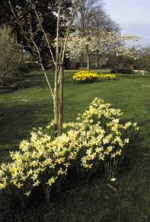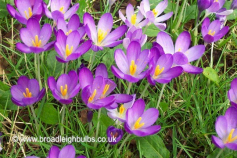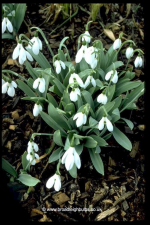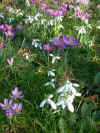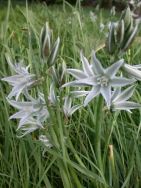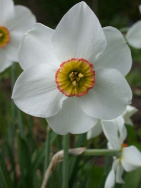Formal
Informal
Planting Methods
Varieties
Introduction
One of the most powerful images of spring is the sight of thousands of daffodils gently billowing under cherry trees. This concept is immediately appealing, and as there are many bulbs that are suitable for naturalising it is, with a little planning, one of the easiest to achieve, albeit on a limited scale.
Two distinct approaches can be pursued. To most gardeners naturalising means growing bulbs in grass instead of borders. However in the strictest sense it means bulbs growing and seeding as they would in the wild; i.e. “in nature”. The gardener therefore has the choice.
Whichever method is adopted you must remember that the quality of the next year’s display depends upon the current years growth. Leaves must be allowed to die back naturally, or for at least 6 weeks after flowering, no matter how untidy they become. Careful choice of varieties can reduce this problem but not eliminate it.
Formal
With this method the bulbs are planted to give a bold display over a limited period of time, usually in spring, such as crocus or daffodils around the base of a tree or along a driveway. Although it is best to keep to a few varieties in order to enhance the impact, it is perfectly possible to increase the length of time of the display by planting 2 or 3 different varieties but keep each in its own discrete area. By contrast mixed crocus, both the large Dutch hybrids and the smaller chrysanthus varieties, can be more effective than a single colour.
The first thing to decide is the length of time you require the display. By careful choice of varieties it is possible to have a succession of flowers, particularly if you pay attention to their location. I have a large Japanese cherry in my lawn. Round it, right next to the trunk, I have clumps of large flowered snowdrops that start the display in January. Outside these I have 5 irregular clumps of different cyclamineus daffodils which have been chosen to give me 6 weeks continuous display early in the spring. As they fade so a patch of the delicate snakes head fritilary (Fritillaria meleagris) produce their beautiful chequered purple flowers to coincide with the snowy blossom of the cherry. Crocus could easily be added to fill the gap between the snowdrops and the daffodils.
As all these bulbs are planted in a formal lawn and their leaves are going to be around for some time, ease of mowing around them is of paramount importance. Tight circles may be easy to plant but it is very difficult to manoeuvre a mower around them. An eliptical or rounded diamond shape is much easier to maintain as well as having a softer, more attractive
One of the most common complaints about daffodils is their rather lax, untidy nature once they have finished flowering. Dead heading the bulbs not only encourages a larger bulb to form for the next year it also improves the appearance of the clumps as it allows the leaves to blend into their surroundings. Snowdrops, crocus and fritilaries can be left to seed.
Informal
This approach allows the gardener much greater scope as there is an almost unlimited timescale. However you must remember that the grass has to be cut at some time. The guiding factor is the appearance of the bulbs. Although it is not always possible to use only ‘wild’ bulbs as many have very specific soil requirements it is possible to choose easier hybrids to give a similar effect. We are not trying to copy nature, just give an illusion of it. It is therefore best to avoid large, ‘modern’ looking hybrid daffodils.
Unless you are fortunate enough to have an orchard, is is best to define the area to be planted by maintaining a neatly mown border round it and, if it is a large area, a path through it. Then, unlike the formal method, most of the bulbs should be planted randomly over the area to give the illusion that they have seeded. This is especially true of crocus, both autumn and spring flowering, snowdrops, fritillaries and bluebells. Species daffodils such as Lent Lily ( N lobularis) can be treated in the same way but hybrids such as the delicate white ‘Thalia’ are more effective planted in clumps of 15 to 20 bulbs.
One of the simplest, yet most effective displays I know relies on 3 varieties of daffodils that flower at distinct times, with very little overlap. The early display is from massed small yellow ‘wild’ daffodils, both Lent Lily (N. lobularis) and the Tenby daffodil (N. obvallaris). The dramatic white N. ‘Actea’ follows these and the display culminates with a liberal sprinkling of the May flowering Pheasant Eye daffodil (N. poeticus recurvus).
However you can be more adventurous and introduce a wide range of other bulbs. Greenish-white ornithogalums, blue camassias and even scarlet tulips (to imitate poppies) will add to the drama and perennials such as cowslips and primroses can also be included. The whole area should then be left until all the seed has been dispersed when the grass can be cut and removed. It must then be regularly mown until the first bulbs appear. In my case this is Crocus speciosus in mid September. These flower until mid November when there is just time for a quick cut before the snowdrops start the spring display and the cycle begins once again.
Planting Methods
Remember that these bulbs are to be left undisturbed for many years so the initial planting should be well spaced. Although the display may look a little thin at first it will soon fill out. It will also take a bulb 4-7years to reach flowering size from seed so patience is essential. It may be necessary to ‘top up’ the display with fresh bulbs from time to time.
1. Bulb planters, both long and short handled, are ideal for planting larger bulbs. Make sure the hole is deep enough and push the plug back firmly. Not ideal for small bulbs such as crocus.
2. Lift a square of turf and then plant underneath using a trowel. Press the turf back firmly and plant a few bulbs between each square to maintain the natural appearance.
3. Some bulbs can be difficult to establish in grass, especially fritillaries. Pot 3-5 bulbs in JI No.2 in a 9cm pot. Plant out in compost plug in final position when coming into growth. Do not replace the turf. Small species narcissus such as N.bulbocodium also respond well to this treatment and it is a good method of filling any gaps as adding bulbs to an existing display at the normal autumn planting time can be quite tricky.
Suggested Varieties
Autumn – we sell these bulbs in August/Sept
- Crocus speciosus; ideal for both formal or informal. Seeds freely. Tolerates light shade.
- Colchicums can be grown in grass but their untidy leaves persist well into mid summer.
Winter / early spring – we sell these bulbs in spring (snowdrops) & autumn
- Snowdrops; The common single and double Galanthus nivalis are the easiest to establish although they can be temperamental. Bulbs should not dry out before planting. The larger hybrids like G. S.Arnott, G. Atkinsii can be used in more formal areas.
- Crocus; The delicate silvery-purple Crocus tommasinianus and its hybrids are ideal for informal plantings as they seed freely. Other crocus for naturalising include C. chrysanthus, C. seiberi, and Dutch crocus.
- Anemone; The blue A. blanda will naturalise in sunny soils. A. apennina prefers a cooler position.
- Aconites; Eranthis hyemalis requires a dry situation, especially in summer and does best in thin grass under trees.
Spring- we sell these bulbs in the autumn
Daffodils
1. Most species daffodils have special soil requirements.
N. lobularis (lent lily) requires a soil that is not too dry and may take a couple of years to establish. Once happy it will seed freely. N. ‘W. P. Milner’ is a useful alternative.
N. minor ( usually listed as N. nanus)is an easy dwarf yellow species. N. obvallaris ( Tenby daffodil) is a vigorous variety with early bright yellow flowers. N. bulbocodium (hoop pitticoat)needs a damp acid soil to grow well as does the beautiful N. cyclamineus. The late flowering Pheasant eye daffodil (N. poeticus recurvus) must not be too dry or it will abort its flowers.
2. Hybrid daffodils
These are much more vigorous and there are many suitable for growing in grass. Most catalogues will indicate the best. Good varieties include N. ‘February Gold’, ‘Peeping Tom’, ‘Jack Snipe’, ‘Little Witch’, ‘ Thalia’, ‘Tresamble’, ‘Telamonius Plenus’ (‘Van Sion’- the old double daffodil) ‘Rip Van Winkle’, ‘Ice wings’.
Leucojum; L aestivum, the summer snowflake, will naturalise in grass that is not too dry.
Hermodactylis tuberosa looks like a green and black iris. It will spread freely on dry, sunny soils in the south.
Bluebells; The true bluebell (Hyacinthoides non scriptus ) will not compete with coarse grass, preferring a shaded site with a light soil. The Spanish bluebell is much more vigorous and will grow almost anywhere and increases rapidly. Although not a bluebell the common grape hyacinth can be easily grown in grass.
Fritillaries: F. mealeagris is naturally a bulb of damp water meadows and is intolerant of thin, dry soils.
Summer
Ornithogalum nutans has unusual greenish-white flowers.
Camassia; Most of these are suitable for naturalising, especially the smaller C. quamash, C,q.’Orion’ and the blue forms of C. leichtlinii. They are happy on both dry or wet soils.
Alliums; small species such as the golden garlic (A. moly) are suitable for wild areas and some of the tall drum stick varieties A hollandicum would make unusual additions to this as well.
Tulips; T. saxatilis has successfully naturalised in some mild gardens otherwise tulips tend to be a relatively short lived but colourful addition.
Lilies; It is possible to naturalise the early golden L. pyranaicum and the lovely purple L. martagon but they require ample moisture when growing and delay the cutting of the grass until the autumn.
This is not an exhaustive list. Others suitable for naturalising are marked with N in the illustrated Autumn catalogue available at the end of May each year.
See Online Store for availability or Illustrated lists for pictures of the bulbs mentioned.

